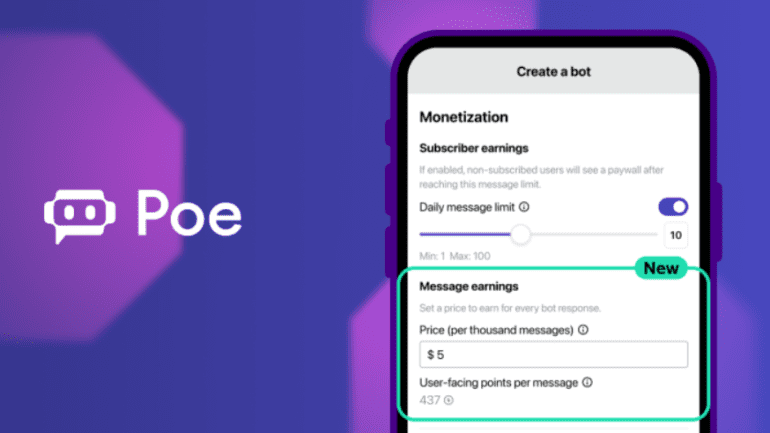- Poe, a Quora-owned AI chatbot platform, introduces a price-per-message revenue model for bot creators.
- This model allows creators to set prices for user interactions, complementing the existing revenue-sharing program.
- Creators can earn revenue from user subscriptions to Poe’s premium service as well.
- Quora CEO Adam D’Angelo emphasizes the importance of covering operational costs for developers.
- The new revenue model is expected to stimulate the creation of diverse bot categories and enhance the ecosystem.
- Initially available only in the US, the monetization opportunity will expand globally.
- Poe also launches an enhanced analytics dashboard for creators to track bot performance and optimize revenue strategies.
Main AI News:
In a groundbreaking move, Poe, the AI chatbot platform under the wing of Quora, unveils a pioneering revenue model aimed at empowering bot creators financially. This recent development opens up fresh avenues for creators to monetize their innovations effectively. The newly introduced revenue model enables creators to establish a price-per-message structure for their bots, ensuring they earn with each user interaction. This strategic addition comes hot on the heels of the October 2023 launch of a revenue-sharing initiative, promising creators a share of profits from user subscriptions to Poe’s premium service.
Since its inception by Quora in February 2023, Poe has been a hub for users to explore a diverse array of AI chatbots, including those crafted by industry giants like OpenAI, Anthropic, and Google. Positioned as a one-stop destination for consumers to experiment with cutting-edge AI technologies, Poe also serves as a fertile ground for Quora to cultivate fresh content.
The revenue models rolled out by the company offer a novel approach to the creator economy, particularly by recognizing and rewarding AI enthusiasts who craft “prompt bots” and developer-built server bots seamlessly integrated with Poe’s AI infrastructure.
Quora CEO Adam D’Angelo, in a statement released on Monday, clarified that Poe users would perceive message points for each bot as equivalent to the points they possess as either free users or Poe subscribers. However, creators will receive compensation in dollars, marking a significant shift in incentivization.
D’Angelo elaborated further, stating, “This pricing mechanism is pivotal for developers grappling with substantial model inference or API costs. Our objective is to foster a thriving ecosystem of model developers and bot creators leveraging these models, and covering operational costs constitutes a fundamental aspect of this endeavor.”
Anticipating the impact of the new revenue model, D’Angelo envisions the emergence of diverse bot categories spanning tutoring, knowledge dissemination, virtual assistants, data analysis, storytelling, and image generation.
While currently exclusive to bot creators in the United States, the platform’s monetization opportunity will extend globally in due course. This initiative supplements the existing creator monetization program, which rewards creators with up to $20 for each user subscribing to Poe through their bots.
In tandem with the per-message revenue model, Poe debuts an enhanced analytics dashboard, providing creators with comprehensive insights into their bots’ performance metrics, encompassing earnings derived from paywalls, subscriptions, and user interactions. This analytical tool, updated daily, equips creators with invaluable data to optimize pricing strategies and enhance bot utilization, thus maximizing revenue potential.
Conclusion:
Poe’s innovative revenue model marks a significant advancement in empowering AI bot creators financially. By introducing flexible pricing structures and providing comprehensive analytics tools, Poe not only incentivizes innovation but also fosters a thriving ecosystem for AI development. This move signifies a shift towards sustainable monetization strategies in the AI market, encouraging further growth and diversification of bot offerings.

